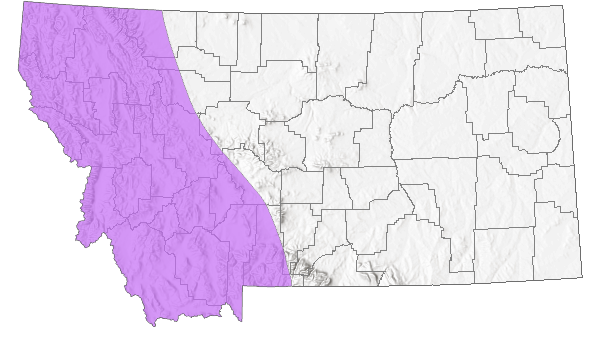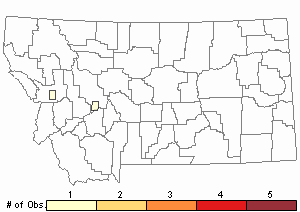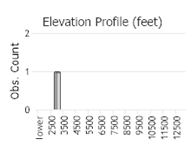View in other NatureServe Network Field Guides
NatureServe
Montana
Utah
Wyoming
Idaho
Wisconsin
British Columbia
South Carolina
Yukon
California
New York
Buckell's Grig - Cyphoderris buckelli
General Description
The following is taken from Hebard (1928), Helfer (1971), Morris and Gwynne (1978), Vickery and Kevan (1985), Capinera et al. (2004), and Scott (2010). The genus
Cyphoderris is represented by two species in Montana, the
Great Grig (
C. monstrosa) and the Buckell’s Grig (
C. buckelli). They are short-winged (tegmina) and flightless. The female wings are reduced to small oval lobes, and male wings are well developed for loud stridulation (“singing”). The Hump-wing Grigs are small to medium sized, robust, and bear similar body colors with contrasting black markings.
Phenology
All Cyphoderris species are believed to overwinter concealed as a nymph, emerging in late spring to early summer when they become an adult in June, and remain active to November or the onset of cold weather (Morris and Gwynne 1978, Vickery and Kevan 1985, and Scott 2010).
Diagnostic Characteristics
The following comes from Hebard (1928), Helfer (1971), Morris and Gwynne (1978), Vickery and Kevan (1985), Capinera et al. (2004), and Scott (2010). The body size for males and females is 17 mm to 26 mm. The most prominent morphological identification features for this species is by examining the shape of the “sternal process” of the males’ genitalia on the 9th abdominal segment (see illustration) which lacks the ventrally-directed, hammer claw-like process and the Ander’s organ of its congener
C. monstrosa.
The two species of
Cyphoderris occurring in Montana are easily confused at first glance. There is also a third North American Grig species, the Sagebrush Grig (
C. strepitans), which occurs only along the Rocky Mountain front of Wyoming and Colorado. Grigs can also be confused with the Decticids—the Shield-backed Katydids (Helfer 1971, Morris and Gwynne 1978, Vickery and Kevan 1985, and Scott 2010).
Species Range
Montana Range
Range Descriptions

 Native
Native
Range Comments
A northwest mountain species occurring from British Columbia, to eastern Washington, Oregon, to Northern Idaho and northwest Montana. It has been reported for three Montana counties (Vickery and Kevan 1985, and Scott 2010).
Observations in Montana Natural Heritage Program Database
Number of Observations: 2
(Click on the following maps and charts to see full sized version)
Map Help and Descriptions
Relative Density

Recency



 (Observations spanning multiple months or years are excluded from time charts)
(Observations spanning multiple months or years are excluded from time charts)
Habitat
The Buckell’s Grig prefers dry forests dominated by
Ponderosa pine (
Pinus ponderosa) or
Douglas fir (
Pseudotsuga menziesii), at higher elevations (Helfer 1971, Morris and Gwynne 1978, Vickery and Kevan 1985, Capinera et al. 2004, and Scott 2010).
Food Habits
This species feeds nocturnally on forest understory plant flowers such as Serviceberry (
Amelanchier),
Arrowleaf Balsamroot (
Balsamorhiza sagittata), and Oregon-grape (
Berberis). Sometimes consumes fruit and other insects (Morris and Gwynne 1978, and Vickery and Kevan 1985).
Reproductive Characteristics
The following is taken from Morris and Gwynne (1978), Vickery and Kevan (1985), and Morris et al. (1989).The males of this species typically call (stridulate) from low shrubs, sagebrush, and small understory trees about knee height (1 meter) from the ground. Otherwise, essentially the same as C. monstrosa.
References
- Literature Cited AboveLegend:
 View Online Publication
View Online Publication Capinera, J.L., R.D. Scott, and T.J. Walker. 2004. Field Guide to Grasshoppers, Katydids, and Crickets of the United States. Ithaca, NY. Cornell University Press.
Capinera, J.L., R.D. Scott, and T.J. Walker. 2004. Field Guide to Grasshoppers, Katydids, and Crickets of the United States. Ithaca, NY. Cornell University Press. Hebard, M. 1928. The Orthoptera of Montana. Proceedings of the Academy of Natural Sciences of Philadelphia, Vol. 80:211-306.
Hebard, M. 1928. The Orthoptera of Montana. Proceedings of the Academy of Natural Sciences of Philadelphia, Vol. 80:211-306. Helfer, J.R. 1971. How to Know the Grasshoppers, Crickets, Cockroaches, and Their Allies. Revised edition (out of print), Mineola, NY: Dover Publications.
Helfer, J.R. 1971. How to Know the Grasshoppers, Crickets, Cockroaches, and Their Allies. Revised edition (out of print), Mineola, NY: Dover Publications. Morris, G.K. and D.T. Gwynne. 1978. Geographical distribution and biological observations of Cyphoderris (Orthoptera: Haglidae) with a description of a new species. PSYCHE 85:2-3.
Morris, G.K. and D.T. Gwynne. 1978. Geographical distribution and biological observations of Cyphoderris (Orthoptera: Haglidae) with a description of a new species. PSYCHE 85:2-3. Morris, G.K., D.T. Gwynne, D.E. Klimas, and S.K. Sakaluk. 1989. Virgin male mating advantage in a primitive acoustic insect (Orthoptera: Haglidae). Journal of Insect Behavior 2(2).
Morris, G.K., D.T. Gwynne, D.E. Klimas, and S.K. Sakaluk. 1989. Virgin male mating advantage in a primitive acoustic insect (Orthoptera: Haglidae). Journal of Insect Behavior 2(2). Scott, R.D. 2010. Montana Grasshoppers, Katydids, and Crickets A Pictorial Field Guide to the Orthoptera. MagpieMTGraphics, Billings, MT.
Scott, R.D. 2010. Montana Grasshoppers, Katydids, and Crickets A Pictorial Field Guide to the Orthoptera. MagpieMTGraphics, Billings, MT. Vickery, V. R. and D. K. M. Kevan. 1985. The grasshopper, crickets, and related insects of Canada and adjacent regions. Biosystematics Research Institute, Ottawa, Ontario. Publication Number 1777. 918 pp.
Vickery, V. R. and D. K. M. Kevan. 1985. The grasshopper, crickets, and related insects of Canada and adjacent regions. Biosystematics Research Institute, Ottawa, Ontario. Publication Number 1777. 918 pp.
- Additional ReferencesLegend:
 View Online Publication
View Online Publication
Do you know of a citation we're missing? Chivers, B.D., O. Bethoux, F.A. Sarria, T. Jonsson, A.C. Mason, and F. Montealegre. 2017. Functional morphology of tegmina-based stridulation in the relict species Cyphoderris monstrosa (Orthoptera: Ensifera: Prophalangopsidae). The Company of Biologists Ltd. Journal of Experimental Biology 220:1112-1121.
Chivers, B.D., O. Bethoux, F.A. Sarria, T. Jonsson, A.C. Mason, and F. Montealegre. 2017. Functional morphology of tegmina-based stridulation in the relict species Cyphoderris monstrosa (Orthoptera: Ensifera: Prophalangopsidae). The Company of Biologists Ltd. Journal of Experimental Biology 220:1112-1121. Dodson, G.N., G.K. Morris, and D.T. Gwynne. 1983. Mating Behavior of the Primitive Orthopteran Genus Cyphoderris (Haglidae). In: D.T. Gwynne and G.K. Morris (eds). Orthopteran Mating Systems. Boulder, CO: Westview Press.
Dodson, G.N., G.K. Morris, and D.T. Gwynne. 1983. Mating Behavior of the Primitive Orthopteran Genus Cyphoderris (Haglidae). In: D.T. Gwynne and G.K. Morris (eds). Orthopteran Mating Systems. Boulder, CO: Westview Press. Gwynne, D.T. 2001. Katydids and Bush-Crickets, Reproductive Behavior and Evolution of the Tettigoniidae. Ithaca, NY: Cornell University Press.
Gwynne, D.T. 2001. Katydids and Bush-Crickets, Reproductive Behavior and Evolution of the Tettigoniidae. Ithaca, NY: Cornell University Press. Hebard, M. 1934. Cyphoderris, a genus of katydid of southwestern Canada and the northwestern United States. Transactions of the American Entomological Society 59:371-375.
Hebard, M. 1934. Cyphoderris, a genus of katydid of southwestern Canada and the northwestern United States. Transactions of the American Entomological Society 59:371-375. Kumala, M., D.A. McLennan, D.R. Brooks, and A.C. Mason. 2005. Phylogenetic relationships within hump-winged grigs, Cyphoderris (Insecta, Orthoptera, Tettigonioidea, Haglidae). Canadian Journal of Zoology 83:1033-1011
Kumala, M., D.A. McLennan, D.R. Brooks, and A.C. Mason. 2005. Phylogenetic relationships within hump-winged grigs, Cyphoderris (Insecta, Orthoptera, Tettigonioidea, Haglidae). Canadian Journal of Zoology 83:1033-1011 Morris, G.K., P.A. DeLuca, M. Norton, and A.C. Mason. 2002. Calling-song function in male haglids (Orthoptera: Haglidae, Cyphoderris). Canadian Journal of Zoology 80:271-285.
Morris, G.K., P.A. DeLuca, M. Norton, and A.C. Mason. 2002. Calling-song function in male haglids (Orthoptera: Haglidae, Cyphoderris). Canadian Journal of Zoology 80:271-285. Spooner, J.D. 1973. Sound production in Cyphoderris monstrosa (Orthoptera: Prophalangopsidae). Annals of the Entomological Society of America 66:4-5.
Spooner, J.D. 1973. Sound production in Cyphoderris monstrosa (Orthoptera: Prophalangopsidae). Annals of the Entomological Society of America 66:4-5.
- Web Search Engines for Articles on "Buckell's Grig"
- Additional Sources of Information Related to "Insects"





